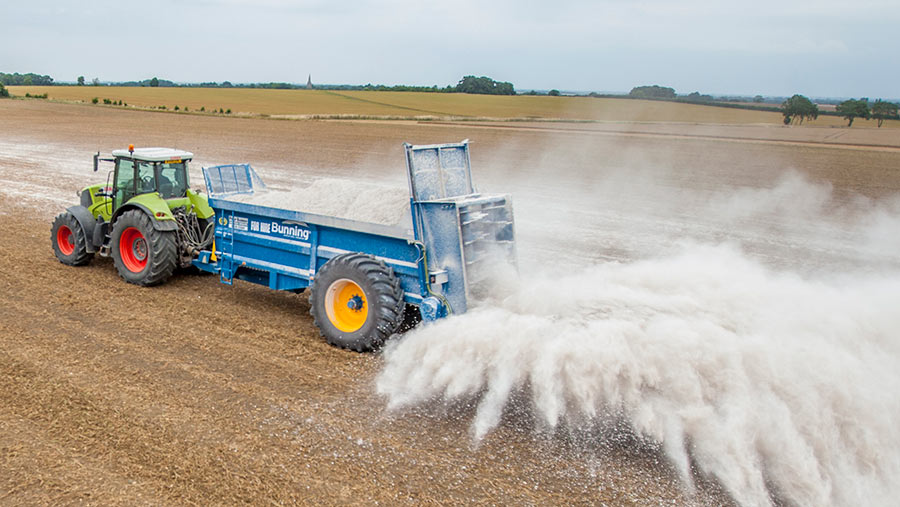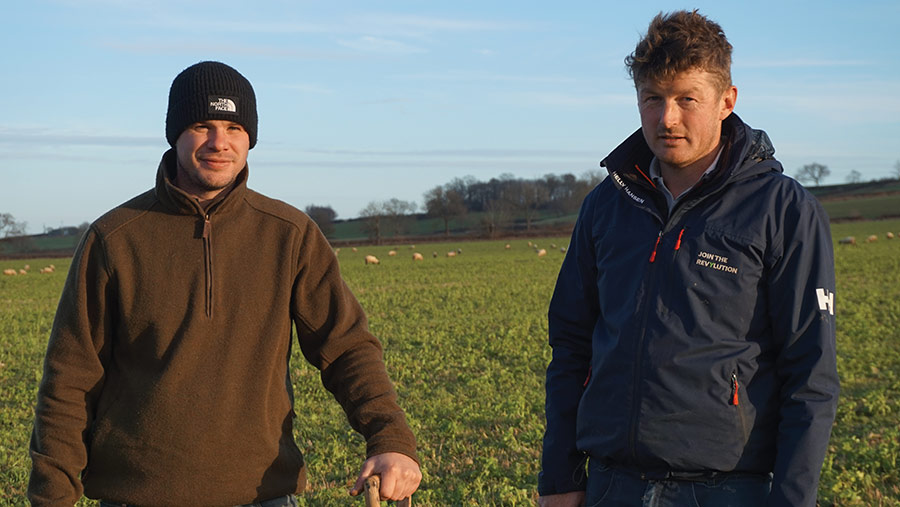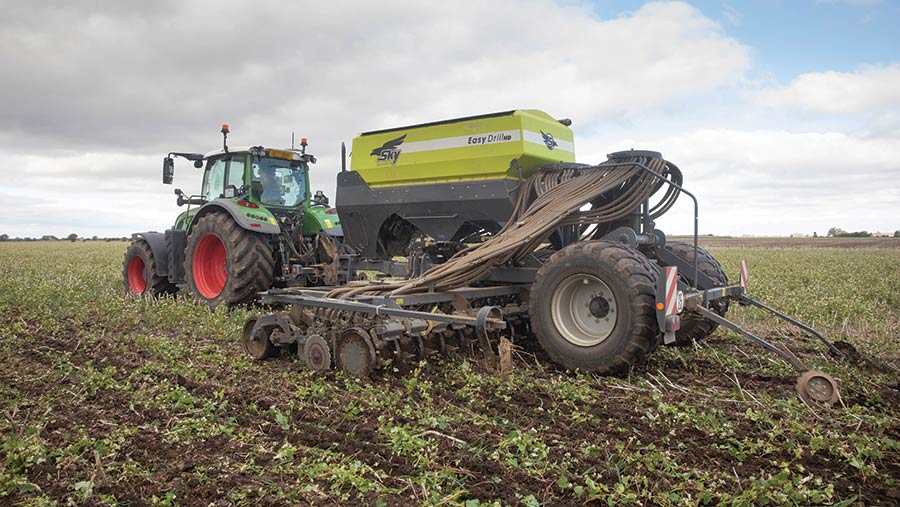How one Leicestershire farm is tackling high magnesium soils
 © farmingphotography.co.uk
© farmingphotography.co.uk Soils with high levels of magnesium are often described as being tight and sticky which, combined with phosphate lock-up, can be difficult to manage.
This was the challenge facing Dan Belcher and his brother Tom, who farm 3,000ha of cropping on heavy land a few miles south of Melton Mowbray.
The 400ha home farm, March House Farm, had a well-established rotation of arable, including maize, and livestock. Dan says yields were good and input costs acceptable.
See also: How to control wireworm in potatoes effectively
Farm facts: March House Farm
- Area 400ha home, plus contract and tenancies of 3,000ha
- Cropping Five-year rotation of winter wheat, winter barley, first wheat, spring beans, and either an oilseed rape or a cover crop. Spring beans are not performing well, and set to be replaced with spring oats
- Drills Tine-based Horsch Sprinter and a John Deere 750A direct drill
In 2019, the brothers had the opportunity to take on a fairly large area of arable cropping. The new land was typical Leicestershire heavy clay, which was compacted.
Dan says there was “a weed burden and things seemed tired”.
The brothers wanted to take the same mixed farming approach to the new land, using their 2,000 sheep and 500 cattle.
So they set out to improve soil health with the help of Hutchinsons agronomist Ed Brown.
Ed recalls that the soil was suffering from a legacy of heavy cultivations on the farm, and a narrow rotation.
“The ground was heavy and compacted, we were seeing lots of run-off and gullying. The high magnesium soils were not draining, which was making crop establishment difficult,” he says.
They came up with a multipronged approach, which included targeted cultivations, applying gypsum, and introducing cover crops.
Cracking compaction
The first action was to mechanically break up the compaction. Ploughing was carried out on the compacted areas with bad blackgrass, as a reset.
On areas where blackgrass wasn’t such an issue, a low-disturbance subsoiling was used instead to crack the compaction.

Agronomist Ed Brown (left) and Dan Belcher (right) © Niamh Tye
Gypsum
Complementing the cultivations, they also started a programme of gypsum applications.
Hutchinsons soil expert Ian Robertson explains that the high-clay soil (45-50% clay) holds onto cations such as magnesium, calcium and sodium.
A lot of magnesium will pull the clay particles together tightly and squeezes soils. This leads to very narrow pores, at less than 0.003mm.
Applying calcium (gypsum) to substitute some of the held magnesium will open the soil up, and the results will last longer than using steel.
Ian recommends applying gypsum every three or four years, and farmers probably need to do this two or three times.
Other measures such as cover cropping will reduce the need for further applications.
The legal limit is 1t/ha, but they applied 5t/ha with a derogation from the Environment Agency.
Ian says this was the optimum rate in trials, which also showed that sulphate leaching can occur at excessive rates of 12t/ha.
Applying gypsum will also help phosphate availability. There is plentiful phosphate with 1,000kg/ha locked up (see “Soil analysis”), but there is only 67kg/ha available.
To overcome the lack of available phosphorus, they have been placing phosphate next to the seed. This will help encourage root growth, and try to recycle P.
Lime versus gypsum
Lime and gypsum are both calcium-containing minerals that are used as soil amendments, but they have very different properties.
Hutchinsons soil expert Ian Robertson explains that lime is a pH shifter, as it adds hydrogen. In contrast, gypsum does not change the pH.
Gypsum is applied to change cations in the soil, supplying calcium to replace some of the magnesium bound by the clay particles.
As the pH is acceptable at March House Farm, gypsum is being used to restructure soil rather than alter the pH.
Soil analysis
High magnesium clays are a challenge, and the aim is to get the biology functioning.
But to understand what’s driving the soils at March House Farm, Hutchinsons soil expert Ian Robertson says a detailed soil analysis was required.
He points to one field where analysis showed a pH of 6.8 and a total phosphate of 1,093kg/ha. At first glance, the good pH and plentiful total P suggests there are no issues.
But he warns that this does not necessarily mean all the P is available.
“You have to look multidimensionally and not rely on one measure, as soils are complex,” he says.
In fact, the phosphate is locked up with 67kg/ha available against a desired 118kg/ha.
He says to imagine a fridge with readily available nutrients. A deep freezer represents food that is less available.
Plants don’t want nutrients in solution, they want them to be readily available.
A functioning soil will recycle nutrients more, moving them from the freezer into the fridge.
Ian says biology is the best way to get this process flowing, and this is fuelled by photosynthesis.
“Therefore, that’s why we don’t want bare soil. If bare, you are not capturing sunlight, and not cycling nutrients.”
More detailed soil sampling also revealed pockets of low pH in one field of winter barley.
These were corrected where needed, and Dan saw a 1t/ha difference in yield.
His agronomist Ed Brown explains that winter barley is sensitive to pH and they are planning to map fields with TerraMap, which takes 800 points across each hectare.
“Then it tells you where to do the soil sampling, rather than doing a W transect across the field.”
Their aim is to tackle these pockets of lower pH before seeing the 1t/ha yield loss.
Ian explains why these lower pH pockets occur. The detailed soil analysis results include active pH and buffer (resting) pH.
A higher buffering level means something is making the soil more acidic than it should be, so you need to determine why.
Liming may help, but it won’t solve the problem, he says.
He believes it could be down to poor micro drainage through soil aggregates because of the tight pores caused by high magnesium levels. “Waterlogging causes lower pH.”

© Tim Scrivener
Cover crops
Dan has also introduced cover crops, which will not only help soil structure by getting nutrients, such as phosphate, cycling in the soil, but provide forage for the sheep.
Hutchinsons technical manager Dick Neale says buckwheat is particularly useful, as the plant can help solubilise it by releasing acid in roots that start to access the locked-up P.
If there is a pH problem, legumes will acidify the root zone and help nutrient flow in soil.
“So combined with gypsum applications, cover crops will help get soils functioning,” says Dick.
Dan says he is already seeing improvements to soil health from the multipronged approach.
“We took on another block of land, which we flatlifted to remove tramlines.
“Our existing areas felt more springy under foot, and we could go faster with the flatlift because the soil had opened up a bit,” he says.
Cover crop tips
Farmers setting out to grow cover crops for the first time should opt for mixes containing at least eight different species, says Hutchinsons Dick Neale.
That’s because on most soils, farmers will only establish five out of the eight.
“If you go for fewer, you can end up with a very thin crop. So if you lose 30% of the mix [containing eight different species], you still have a good crop,” he says.
He recalls one site that had not grown legumes for years. They found that legumes in the mix did not survive.
Dick advises farmers to see what grows before making any decisions.
The Hutchinsons mix includes linseed, buckwheat, phacelia, tillage radish, fodder radish, brown mustard, hairy vetch and crimson clover.
Once you know what grows well, you can then tailor the mix. Hutchinsons offers a range of mixes, with the same eight species in different ratios.
But he warns against opting for a cheaper mix to qualify for the Sustainable Farming Incentive payment – the scheme only requires two species.
“So if you go for a cheap mix of mustard and something else, the mustard will dominate and you will end up with just one species.
“But to maximise soil health, you need diversity in a cover crop.”
Two drills
Farmers direct-drilling on heavy soils ideally just need two drills – a tined model and one with discs.
No other associated cultivation kit is needed, says Dick.
The tine drill is needed for establishing the cover crop after harvest, as the best results are seen after cultivating slightly to create a bit of tilth.
It needs to be aggressive enough to move the top 8cm (3in) of soil, so a Claydon and Mzuri would be good to put in a cover crop. A Horsch Sprinter would also work.
He points out that a number of drill manufacturers, such as Kverneland, are doing retrofit kits, so farmers can cultivate without having to buy a new drill in addition to their disc drill.
“It doesn’t even have to be a drill, a low-disturbance seeder unit works well in putting a cover crop in, like we did with OSR.”
Hutchinsons cover crop mixes are designed so that they can be drilled this way with their smaller seed size.
The mixes do not include peas and beans, as Dick says to cope with these larger seeds means you lose control of small seed species.
Then the disc drill can be used to establish the cash crop. He says there is no need to use all the associated equipment, such as subsoilers and other deep cultivators.
However, Dick adds that one exception is on sand soils, where farmers need to do more cultivation as soils can slump.
The lack of clay means they don’t naturally restructure, so a subsoiler may be needed to break the compaction at depth.

